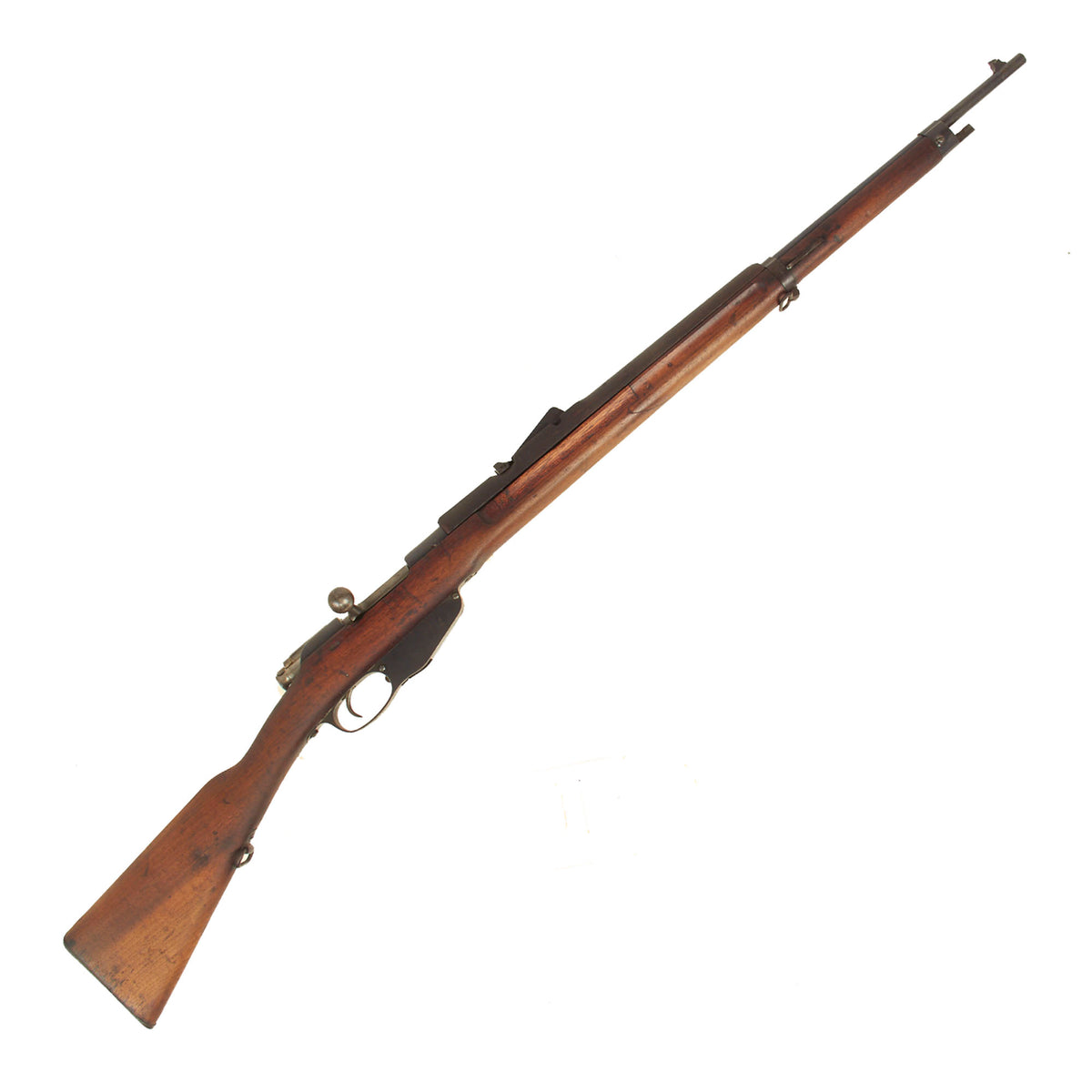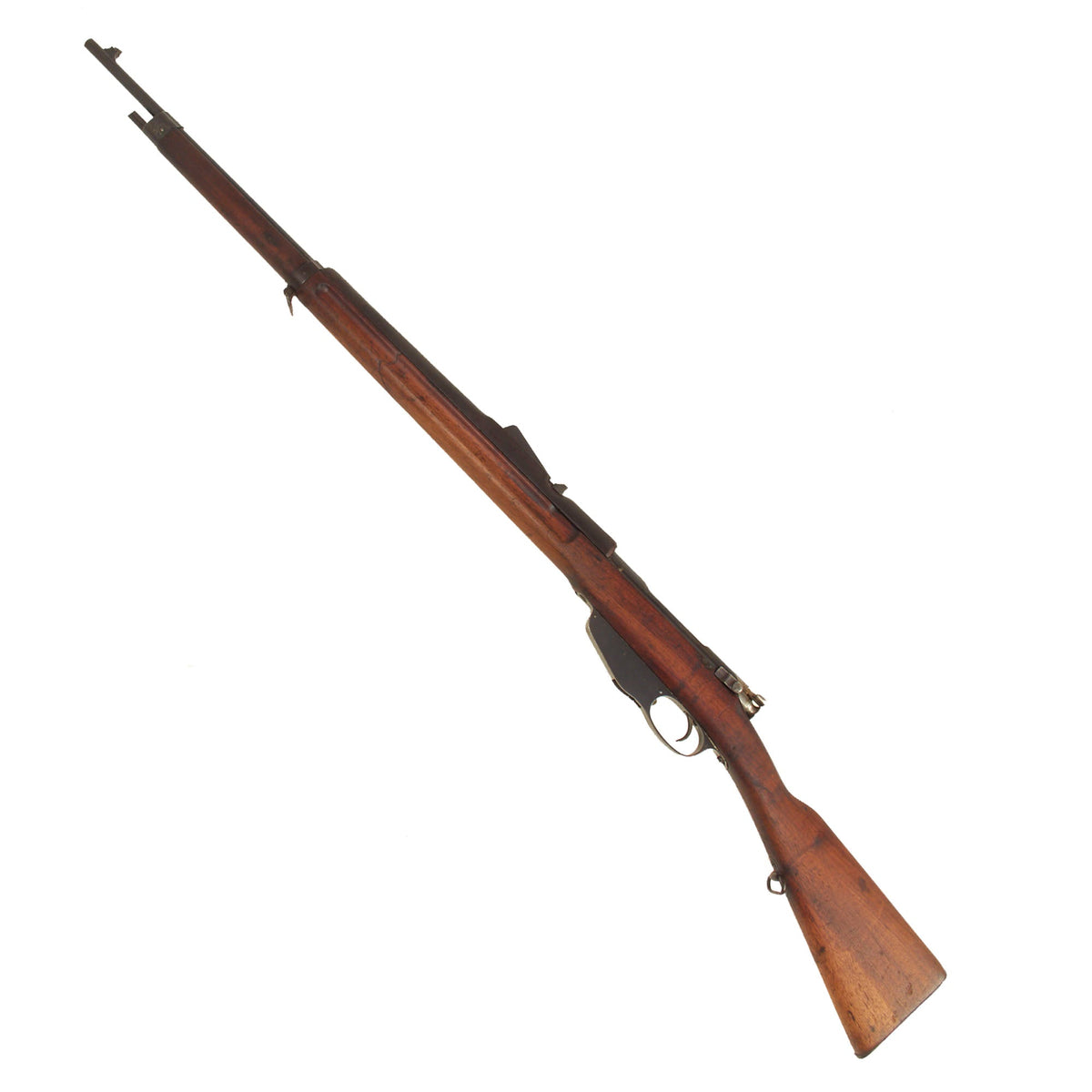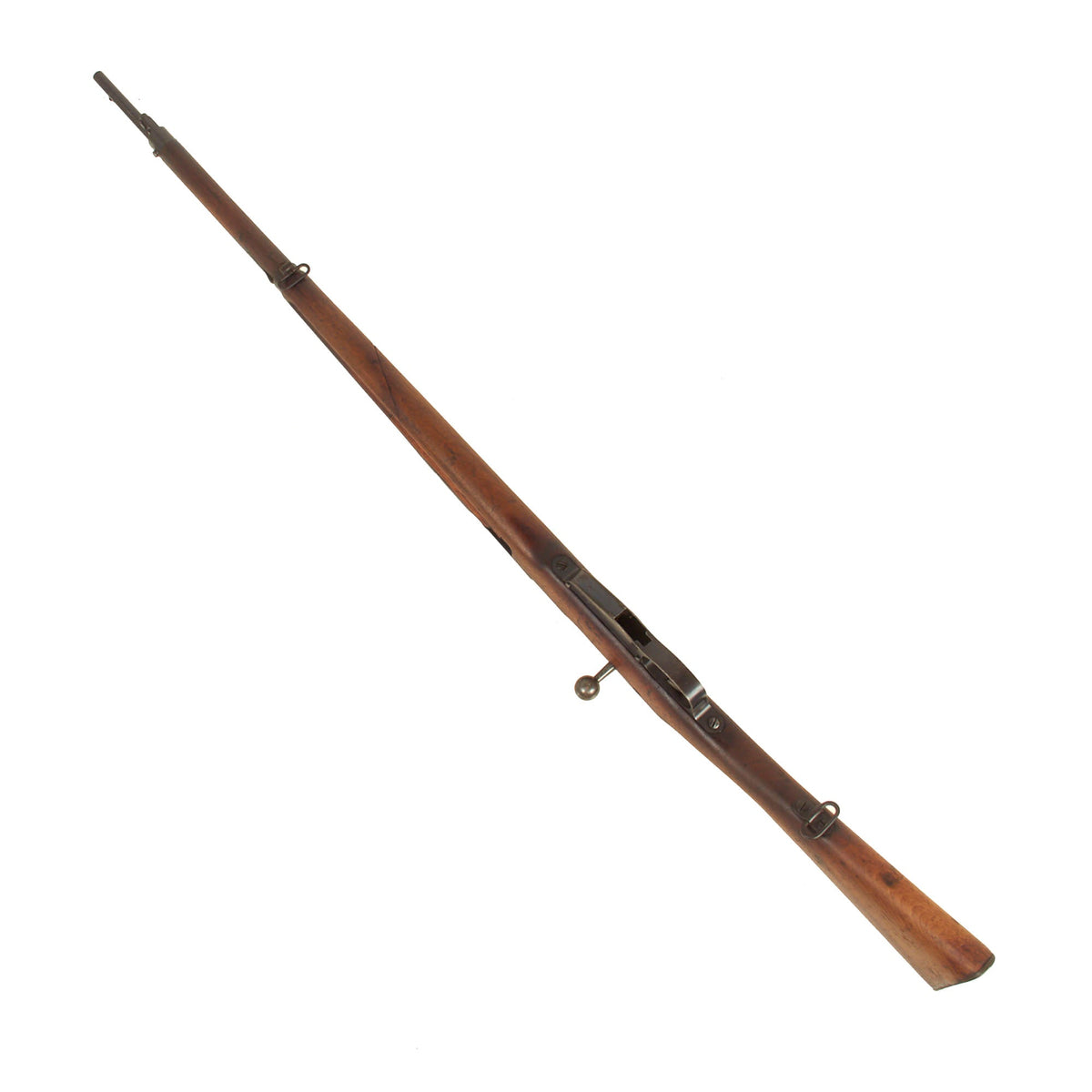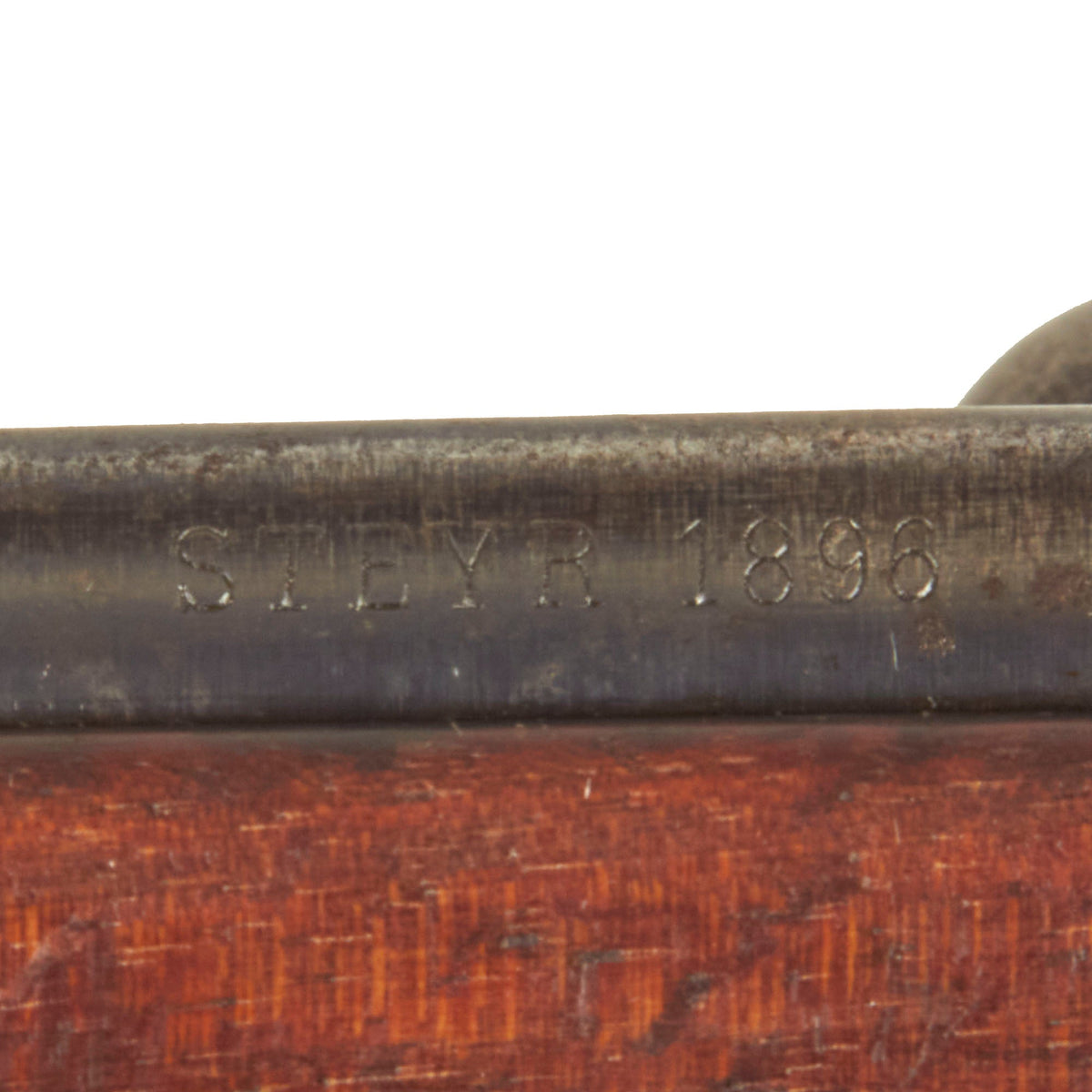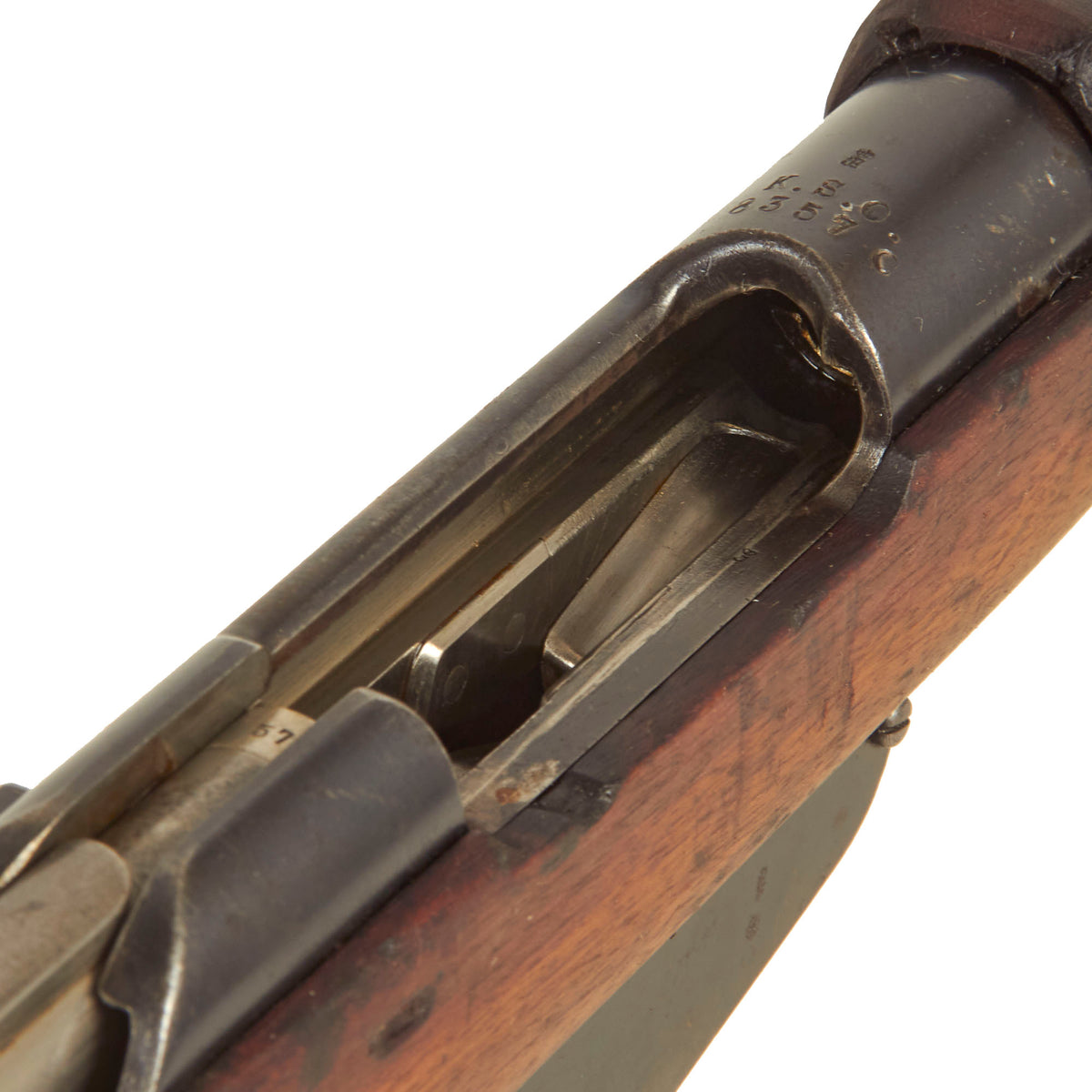Original Dutch Pre-WWI Geweer M. 95 Mannlicher Rifle by ŒWG Steyr Converted to K.S.O. .22 Trainer – Serial 8357C – Dated 1896 Original Items
$ 1.095,00 $ 273,75
Original Item: Only one Available. This is a very interesting example of the Dutch Geweer M.95 Mannlicher Infantry Service rifle, which was the standard Dutch long rifle from 1895 and through WWI. It was still in service in some areas until at least 1955, especially by the Royal Netherlands East Indies Army (Koninklijk Nederlands Indisch Leger or KNIL).
This rifle however does not look to have seen colonial service, and instead was converted to a .22 Training rifle, which we believe happened at Hembrug Arsenal in the Netherlands. It bears the “K.S.O.” marking on the receiver for Kamer Scheit Oefening (room target practice), indicating it was converted to be a .22 trainer, possibly for indoor use. These rifles were somewhat experimental, and there is unfortunately not much information out there on these. The barrel is definitely in .22, and the bolt and magazine have definitely been modified for a shorter cartridge, however we are unable to find exactly how they were configured for use. The chamber looks to be almost full size, so it is possible that training cartridges were some type of adapter. Definitely a great opportunity for further research.
This rifle was originally manufactured by the Steyr Mannlicher firearms division of Österreichische Waffenfabriksgesellschaft (ŒWG, Austrian Arms-Manufacturing Company) in Austria. The right side of the receiver is simply marked STEYR 1896, with the end of the receiver marked with a proof and the serial number:
CROWN / B
K. S. O.
8357C
The end of the barrel under the hand guard has the same 8357C serial number stamped. The bolt is also marked 8357, with the magazine, rear sight, and front barrel band marked with shortened number 57. The lower barrel band and bolt release are non-matching, so some parts were definitely swapped out over the years. The “CROWN / B” inspection mark is attributed to inspector E.B. Brossois, who also would travel to inspect contract bayonets for these rifles.
Rifle is in very good used condition, and is solid overall. The metalwork still has a lot of the original bluing present, even under the handguard, though there is definitely some light rusting from wood contact there as well. The stock has a lovely color, showing moderate wear from service. The handguard on these KSO rifles is longer than standard, as on this example, and looks to have been made from a different wood than the rest of the stock. The rifle cycles correctly with a strong dry fire, however we have no idea if it works correctly. The bore shows lands and grooves, though it does show use and some rounding of the lands.
A very nice experimental Dutch .22 converted Training rifle. Ready to research and display!
Specifications:-
Year of Manufacture: 1896
Caliber: .22
Cartridge Type: Unknown
Barrel Length: 31 Inches
Overall Length: 51 Inches
Action type: Bolt-Action
Feed System: 5 round internal magazine with En-Bloc clip
History of the Dutch Mannlicher
The Geweer M. 95, also known to collectors as the Dutch Mannlicher, was the service rifle of the Armed forces of the Netherlands between 1895 and 1940 which replaced the obsolete Beaumont-Vitali M1871/88. At first it was produced by Steyr for the Dutch, but after 1904, production took place under license at Hembrug Zaandam in the Netherlands. Although often regarded as being based on the earlier Mannlicher 1893 Model, the rifle is in fact a modification of the Mannlicher rifle by August Schriever and the Dutch rifle commission[2]. The Dutch issued about 470,000 M.95s.
Both Dutch and Romanian rifles fired the same rimmed cartridge often referred to as “Romanian” 6.5×53.5mmR or “Dutch 6.5” 6.5×53 mmR. In military service, Dutch M.95 rifles (6.5×53 mmR) cartridges are loaded primarily through the use of an en-bloc clip, similar in concept to the clip used later by the US Army’s M1 Garand. With the Ferdinand Mannlicher designed trigger guard / magazine housing assembly, when the bolt is open and fully retracted to the rear the full en-bloc clip is loaded into the magazine from the top through the open receiver. The empty clip will fall out through a hole in the base of the magazine housing when out of cartridges. This enabled quick reloading of the rifles during combat. When the bolt is in the fully open and retracted position, full clips can be vigorously ejected upwards from the magazine housing by means of a spring loaded latch at the rear of the magazine. This is operated by a recessed button in the front of the trigger guard portion of the assembly. The clips were essentially disposable as ammunition would be issued already loaded into clips from the factory.
Fast Shipping with Professional Packaging
Thanks to our longstanding association with UPS FedEx DHL, and other major international carriers, we are able to provide a range of shipping options. Our warehouse staff is expertly trained and will wrap your products according to our exact and precise specifications. Prior to shipping, your goods will be thoroughly examined and securely secured. We ship to thousands clients each day across multiple countries. This shows how we're dedicated to be the largest retailer on the internet. Warehouses and distribution centres can be located throughout Europe as well as the USA.
Note: Orders with more than one item will be assigned a processing date depending on the item.
Before shipping before shipping, we'll conduct a thorough inspection of the items you have ordered. Today, the majority of orders will be delivered within 48 hours. The delivery time will be between 3-7 days.
Returns
The stock is dynamic and we cannot completely manage it because multiple stakeholders are involved, including our factory and warehouse. So the actual stock may alter at any time. It's possible that you may not receive your order once the order has been made.
Our policy is valid for a period of 30 days. If you don't receive the product within 30 days, we are not able to issue a refund or an exchange.
You can only return an item if it is unused and in the same state as the day you received it. You must have the item in its original packaging.
Related products
Uncategorized
Australian WWII Owen MK1 Machine Carbine SMG Custom Fabricated Replica with Sling Original Items
Uncategorized
Uncategorized
Uncategorized
Uncategorized
Uncategorized
Uncategorized
Uncategorized
Uncategorized
Angolan Rebel 1970s era 60mm Inert Display Mortar from Angolan Civil War Original Items
Uncategorized
Uncategorized
Uncategorized
Uncategorized
Armored Burgonet Helmet & Polearm from Scottish Castle Leith Hall Circa 1700 Original Items
Uncategorized
Uncategorized
Uncategorized
Uncategorized
Armoured Fighting Vehicles of the World: AFVs of World War One (Hardcover Book) New Made Items
